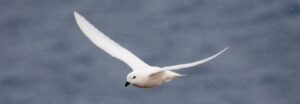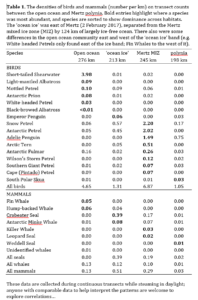By Peter Ryan, onboard scientist, expert in general ornithology, seabird-fishery interactions, evolutionary ecology, marine debris, solid waste management, biology of oceanic islands.
Leg 2, Mertz to Balleny
Today (3 February) we celebrated day 45– the halfway mark for ACE. Over the last few days, the long hours of daylight resulted in a break in daily blogs as we focused on maximising transect time. The transit from Mertz Glacier to the Balleny Islands involved some spectacular cruising through extensive fields of brash ice interspersed by stretches of open water. Interestingly there were quite distinct mammal and bird communities in the different areas of ice and open water encountered (see the digital version of the blog for more details). The following lists all the birds and mammals counted in transect over the last three days since leaving the Mertz polynia early on 1 February:
| Short-tailed Shearwater | 1106 | Snow Petrel | 484 |
| Antarctic Petrel | 405 | Adelie Penguin | 179 |
| Arctic Tern | 121 | Antarctic Fulmar | 67 |
| Mottled Petrel | 52 | Cape (Pintado) Petrel | 38 |
| Antarctic Prion | 28 | Light-mantled Albatross | 24 |
| Wilson’s Storm Petrel | 22 | Emperor Penguin | 14 |
| Southern Giant Petrel | 17 | South Polar Skua | 6 |
| White-headed Petrel | 7 | Black-browed Albatross | 1 |
| Crabeater Seal | 116 | Antarctic Minke Whale | 35 |
| Hump-backed Whale | 22 | Fin Whale | 14 |
| Killer Whale | 8 | Leopard Seal | 4 |
No kelp or litter was seen, and water samples in the Mertz polynia were pretty clean, but we found fibres again en route to the Ballenys.



